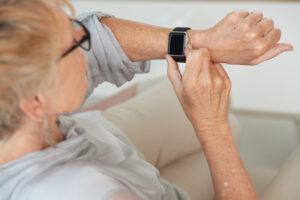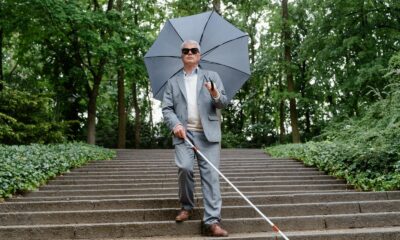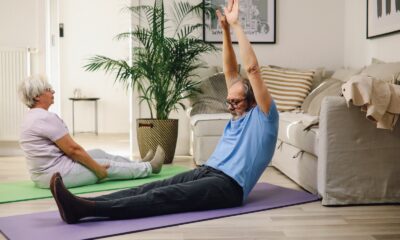Blog
What Are Three Safety Devices For Seniors?
Discover three essential safety devices for seniors in this informational post. From fall prevention devices to communication devices, these innovative solutions offer security and peace of mind. Find out how grab bars, medical alert systems, and pill organizers can make a difference in seniors’ lives.
worToday, we want to highlight the importance of safety for our beloved seniors. As they gracefully age, it becomes crucial to ensure their security and well-being. In this article, we will explore three essential safety devices specially designed to protect and assist seniors in their daily lives. From personal emergency response systems to medication reminders, these devices offer peace of mind to both seniors and their loved ones. So let’s discover the innovative solutions that help make their golden years even more secure and worry-free!
Fall Prevention Devices
When it comes to ensuring the safety of seniors in their homes, fall prevention devices play a crucial role. These devices are designed to provide stability and support, reducing the risk of slips, trips, and falls. Here are three essential fall prevention devices that every senior should consider:
Grab Bars
Grab bars are sturdy handrails that can be installed in various areas of the home, such as in the bathroom, near staircases, or in hallways. These bars offer a reliable grip, allowing seniors to maintain their balance and prevent falls. Installing grab bars near toilets, showers, and bathtubs can greatly enhance safety, making it easier for seniors to move around independently.
Non-slip Mats
Non-slip mats are an excellent addition to any home, particularly in areas prone to wetness, such as the bathroom or kitchen. These mats provide a slip-resistant surface, reducing the chances of accidental falls. With their textured design and anti-slip properties, non-slip mats offer seniors a stable and secure footing, even on tiled or slippery surfaces.
Bed Rails
Bed rails are essential safety devices that can significantly reduce the risk of falls for seniors while they sleep. These railings are placed on the sides of the bed and act as a protective barrier, preventing individuals from rolling off the bed and potentially getting injured. Bed rails provide the necessary support and stability, giving seniors peace of mind and a restful night’s sleep.
Communication Devices
Maintaining communication and ensuring immediate access to help is vital for seniors, particularly in case of emergencies. Communication devices designed specifically for seniors offer peace of mind and a sense of security. Here are three essential communication devices to consider:
Medical Alert Systems
Medical alert systems are designed to provide instant access to emergency assistance at the press of a button. When a senior wears a medical alert pendant or bracelet, they can easily summon help in case of a fall or any other medical emergency. These systems can be connected to a monitoring center or directly to a caregiver’s phone, ensuring help is just a button press away.
Smartphones and Tablets
Smartphones and tablets have become an essential part of daily life, and they offer a wide range of benefits for seniors. In addition to regular phone calls and text messaging, seniors can use smartphones and tablets to browse the internet, access important medical information, and even maintain social connections through video calls and messaging apps. These devices also often feature emergency call buttons and GPS tracking capabilities.
Two-way Radios
Two-way radios are a simple yet effective communication device for seniors, particularly in larger homes or when outdoors. These radios allow seniors to stay connected with their caregivers or family members, providing a quick and easy way to communicate in case of emergencies or simply to stay in touch throughout the day. Two-way radios are user-friendly, portable, and have a range that suits most residential settings.

Home Security SystemsHome security systems are not only beneficial for preventing break-ins but also contribute to the overall safety and well-being of seniors. These systems offer protection, peace of mind, and various features that enhance safety. Here are three essential components of a comprehensive home security system:
Door and Window Alarms
Door and window alarms are designed to alert homeowners when someone attempts to enter the house without permission. These alarms can be easily installed on doors, windows, and sliding glass doors, providing an added layer of defense against potential intruders. For seniors, these alarms serve as a deterrent and also provide a sense of security, offering peace of mind during both day and night.
Motion Sensors
Motion sensors are a crucial part of any home security system as they detect movement or changes in the environment. These sensors can be installed in various areas of the home, such as hallways, entryways, or near valuables. Seniors can benefit from motion sensors by receiving alerts if unexpected movement is detected, signaling potential threats or intruders.
Video Surveillance
Video surveillance systems provide visual monitoring of the home, both indoors and outdoors. These systems often include cameras that can be strategically placed to monitor vulnerable areas, such as entrances or common living spaces. For seniors, video surveillance offers a sense of security, allowing them to visually monitor who is at their door or keep an eye on their surroundings. Additionally, recorded footage can be beneficial for investigation purposes if any incidents occur.
Medication Management Devices
Managing medications effectively is crucial for seniors to maintain their health and well-being. With the help of medication management devices, seniors can stay organized and ensure they take the right medication at the right time. Here are three essential medication management devices:
Pill Organizers
Pill organizers are simple yet effective tools for seniors to keep track of their medications. These organizers come in various sizes and typically consist of compartments or sections for each day of the week. Seniors can fill these compartments with their daily medication doses, ensuring they take the appropriate pills at the designated times. Pill organizers help prevent missed doses or accidental overdoses, providing a reliable method of medication management.
Automatic Pill Dispensers
Automatic pill dispensers take medication management to the next level by offering programmable features. These devices can be set up to dispense the correct medication at specific times, often with audible reminders or alarms. Automatic pill dispensers can store multiple medications and can be pre-filled, reducing the hassle of organizing medications manually. These devices are particularly beneficial for seniors who may struggle with memory or have complex medication schedules.
Medication Reminders
Medication reminder devices are designed to help seniors remember to take their medications on time. These devices often include alarms, timers, or visual cues to provide reminders throughout the day. From simple wristwatches with vibrating alarms to more advanced electronic systems with customizable reminders, medication reminder devices can greatly improve medication adherence for seniors.

Mobility Aids
Maintaining mobility is essential for seniors to remain independent and navigate their surroundings safely. Mobility aids provide the necessary support and stability to prevent falls and ensure ease of movement. Here are three essential mobility aids for seniors:
Canes
Canes are one of the most common and widely used mobility aids. They provide stability and support while walking, helping seniors maintain balance and reduce the risk of falls. Canes come in various styles, including single-point canes, quad canes, and folding canes, allowing seniors to choose the type that suits their needs and preferences best.
Walkers
Walkers offer greater stability and support compared to canes, making them suitable for seniors who require more assistance while walking. These aids typically have four legs and provide a sturdy frame for seniors to hold onto, promoting balance and confidence. Walkers come in different styles, including standard walkers, rollators with wheels, and those with added features like seats and storage compartments.
Wheelchairs
Wheelchairs are essential mobility aids for seniors who have limited mobility or difficulty walking independently. They offer a seated position and are propelled manually or through battery-powered motors. Wheelchairs provide seniors with the ability to move freely and comfortably both indoors and outdoors, ensuring they can maintain their independence and enjoy a higher quality of life.
Stairlifts
For seniors who struggle with stairs due to mobility issues or balance concerns, stairlifts offer a safe and convenient solution. These devices are installed on staircases and provide a motorized chair or platform that moves along a rail, transporting individuals up and down the stairs effortlessly. Here are three types of stairlifts to consider:
Straight Stairlifts
Straight stairlifts are the most common type and are designed for straight, uninterrupted staircases. These stairlifts run in a straight line without any curves or bends, making them an ideal choice for many homes. Straight stairlifts offer ease of use, reliability, and ensure seniors can navigate their staircases with minimal effort.
Curved Stairlifts
Curved stairlifts are customized to fit staircases with curves, turns, or intermediate landings. These stairlifts follow the exact path of the staircase, accommodating any design complexities. Curved stairlifts are tailored to each unique staircase, ensuring a perfect fit and seamless operation. With curved stairlifts, seniors can safely and comfortably navigate even the most challenging stairs.
Outdoor Stairlifts
Outdoor stairlifts are specifically designed for exterior use, making them suitable for seniors who have steps leading to their front porch, patio, or garden. These stairlifts are built to withstand the elements, featuring weatherproof materials and durable construction. Outdoor stairlifts provide seniors with the freedom to access their outdoor spaces independently, regardless of the terrain or weather conditions.

Bed Alarms
Bed alarms are crucial devices for seniors who are at risk of falls, especially when getting in and out of bed. These alarms notify caregivers or family members when a senior attempts to leave the bed, ensuring immediate assistance can be provided. Here are three types of bed alarms:
Pressure-sensitive Bed Alarms
Pressure-sensitive bed alarms detect changes in pressure, triggering an alert when a senior tries to get out of bed. These alarms typically consist of a sensor pad that is placed underneath the mattress or on top of the bed. When the pressure on the sensor pad is released, an alarm is activated, alerting caregivers or family members to the senior’s movement.
Wireless Bed Alarms
Wireless bed alarms provide the same functionality as pressure-sensitive bed alarms but without the need for a physical connection between the sensor pad and the alarm unit. These alarms use wireless technology to transmit signals, allowing greater flexibility in placement and reducing tripping hazards caused by cords or wires. Wireless bed alarms are convenient, reliable, and easy to set up.
Cordless Bed Alarms
Cordless bed alarms offer similar benefits as wireless bed alarms but with the added convenience of being portable. These alarms feature a wireless sensor pad that is placed under the mattress and a portable alarm unit that can be carried by the caregiver or placed nearby. Cordless bed alarms are ideal for situations where mobility and flexibility are essential, ensuring constant monitoring of bed exits.
GPS Tracking Devices
GPS tracking devices provide an additional layer of safety and security for seniors, particularly those who may have cognitive impairments, wander, or become disoriented. These devices enable caregivers and family members to locate seniors quickly and ensure their well-being. Here are three types of GPS tracking devices:
Smartwatches
Smartwatches equipped with GPS tracking capabilities offer a discreet and convenient way to monitor seniors’ whereabouts. These devices can be worn on the wrist, providing real-time location information to caregivers or family members through a smartphone app or online platform. Smartwatches often include additional features such as heart rate monitoring and emergency call buttons, enhancing the overall safety and functionality.
GPS Personal Locators
GPS personal locators are small, lightweight devices that can be carried in a pocket or attached to a belt or keychain. These locators use GPS technology to relay the wearer’s location coordinates to a designated smartphone or computer. Locators that work with GPS are ideal for seniors who prefer not to wear a watch or who may misplace traditional tracking devices.
GPS Shoe Insoles
A unique and discreet tracking solution for seniors is GPS shoe insoles. These insoles can be inserted into any pair of shoes and provide continuous location tracking without the need for wearing a separate device. GPS shoe insoles are particularly useful for seniors who have a routine of wearing specific shoes or may resist wearing additional tracking devices.
Smart Home Devices
Smart home devices offer convenience, connectivity, and enhanced safety for seniors. With these devices, seniors can control various aspects of their home environment, making everyday tasks easier and more accessible. Here are three essential smart home devices for seniors:
Smart Door Locks
Smart door locks provide keyless entry and improved security for seniors. With smart door locks, seniors can unlock their doors using a keypad, smartphone app, or even voice commands. This eliminates the need for physical keys and ensures easy access for seniors with limited mobility or dexterity. They can also be integrated with other smart home devices, offering a seamless and secure home automation experience.
Smart Thermostats
Smart thermostats allow seniors to remotely control and monitor the temperature of their homes. These devices can be programmed to adjust the temperature based on a pre-set schedule or controlled in real-time using a smartphone or voice commands. These thermostats offer energy-saving features, such as detecting occupancy and adjusting the temperature accordingly, ensuring seniors can maintain a comfortable and safe indoor environment.
Smart Lighting
Smart lighting systems offer convenient and customizable lighting options for seniors. With smart bulbs, switches, or plugs, seniors can control the brightness, color, and timing of their lights using a smartphone app or voice commands. This type of smart lighting can be programmed to turn on and off automatically, simulate occupancy when away from home, and even provide gentle lighting during nighttime trips to the bathroom or kitchen, reducing the risk of falls.
Falls Detection Systems
Falls detection systems provide an added layer of protection for seniors by alerting caregivers or family members when a fall or accident occurs. These systems use various technologies to monitor activities and detect falls in real-time, ensuring prompt assistance can be provided. Here are three types of falls detection systems:
Wearable Falls Detectors
Wearable falls detectors are small devices that can be worn on the body or attached to clothing or accessories. These detectors use motion sensors or advanced algorithms to detect sudden changes in movement or orientation, indicative of a fall. When a fall is detected, an alarm is triggered, and an alert is sent to the designated contacts, allowing for immediate assistance to be provided.
Floor-based Pressure Mats
Floor-based pressure mats are placed strategically on the floor and use pressure-sensitive technology to detect changes in weight distribution. These mats are often installed near beds or in high-risk areas and can detect falls or prolonged periods of immobility. When a change in weight is detected, an alert is sent to caregivers or family members, enabling quick response and intervention.
Video-based Fall Monitoring
Video-based fall monitoring systems utilize cameras and advanced computer vision algorithms to detect falls and other abnormal events. These systems analyze real-time video footage and can identify specific patterns or movements associated with falls. When a fall is detected, an alert is sent to the designated contacts, ensuring rapid assistance can be provided. Video-based fall monitoring offers a non-invasive and discreet method of falls detection.
In conclusion, ensuring the safety and well-being of seniors is of utmost importance, and the wide range of safety devices available can greatly contribute to maintaining their independence and preventing accidents. From fall prevention devices and communication devices to home security systems, medication management devices, mobility aids, and falls detection systems, there are numerous options to address specific safety concerns. By implementing these devices, seniors and their caregivers can have peace of mind knowing that proactive measures are in place to keep them safe.
















